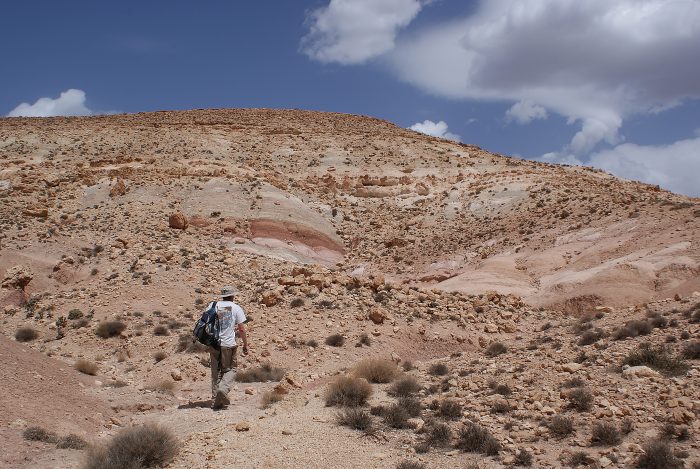
The High Atlas Mountains are the highest mountains in North Africa, running from the Atlantic coast in Morocco to the Mediterranean Coast in Tunisia, over 2500 km in length and reaching a maximum elevation of 4167 m at Mount Toubkal. The significant relief of these mountains creates an important watershed separating the Mediterranean north from the Sahara Desert to the south.
While these mountains may superficially look like other chains, these peaks have not formed as a result of the collision of separate tectonic plates in a typical continent-continent collision. Instead, the High Atlas Mountains are considered an “intracontinental” mountain belt, which formed when an earlier area of rifted crust (similar to the East Africa Rift today) went from being extended to being compressed as a result of changes in wider plate motions.
While this tectonic “inversion” is well understood, the timing and progression of the mountain building event are still under debate, with some scientists advocating a two-phase development with uplift firstly taking place in the Eocene to Oligocene times (~55 – 30 Ma), pausing and then recommencing around 5 Ma. While others suggest a simpler history of continued uplift from the Eocene to the present day.
Understanding the timing and progression of uplift is not only important for models of tectonic development of the Western Mediterranean but also for understanding the timing of aridification in the Sahara Desert, no doubt affected by the formation of the High Atlas as an orographic barrier to rainfall south of the mountains.
Recently, Sarah Boulton and Stephen Grimes from the University of Plymouth (U.K.) and Justin VandeVelde, now at the University of California – Merced, set out to further understand the evolution of the area in the critical Miocene period. The research focused on the characteristics and chemistry of sediments deposited south of the Atlas Mountains, in the adjacent Ouarzazate Basin, during the Late Miocene (~ 13 – 5 Ma). Previously, these limestones were believed to have been deposited in hydrologically closed basins – lakes that had rivers flowing into them but with no outflow. A key piece of evidence used to justify the idea of a pause in mountain growth; however, no geochemical data existed to confirm that environmental hypothesis.

Typical sequence of Miocene lacustrine sediments. Image courtesy Sarah Boulton.
Limestones are composed of calcium carbonate (CaCO3), the ratio of carbon and oxygen isotopes composing the limestone record information about a range of climatic and biotic factors affecting the deposition and formation of these sedimentary rocks. The ratio of 18O to 16O (δ18O) is affected by precipitation, evaporation and the altitude of the river catchment, while the ratio of 13C to 12C (δ13C) is sensitive to the residence time of carbon in water bodies and to the amount and type of vegetation incorporated into the sediment. By looking at these two factors, Talbot (1990) demonstrated that the ratios of carbon and oxygen isotopes are dramatically different depending on whether carbonates are deposited in hydrologically closed or hydrologically open (inflow and outflow) lakes. In open systems, there is no trend between the two isotope ratios (the data clusters), whereas in closed systems there is usually a clear positive linear relationship between the carbon and oxygen isotope ratios.
Therefore, the analysis of these ratios, in conjunction with an examination of the sedimentary features of the limestone, can reveal whether deposition took place in closed or in open lakes. Samples for analysis were selected from five locations, spanning a time period of ~ 7 million years. The results show that during the earlier periods of sediment formation the lakes indeed were hydrologically closed, supporting the previous research. However, at ~ 9.5 Ma the isotopic and sedimentary features underwent a dramatic change, indicating that at this period the lakes became hydrologically open.
This significant change in the hydrology of the Ouarzazate Basin could be the result of increased sediment and water supply to the basin, capture of the basin by the outflow river or a change to the tectonic regime affecting rates of subsidence and uplift. While work is ongoing to unravel the competing influences of these different driving forces, it is clear that the Late Miocene period in Morocco was not as geologically quiet as previously thought.
This research was published in Boulton, S.J., VanDeVelde, J.H. and Grimes, S.T., 2019. Palaeoenvironmental and tectonic significance of Miocene lacustrine and palustrine carbonates (Aït Kandoula Formation) in the Ouarzazate Foreland Basin, Morocco. Sedimentary Geology, 383, 195-215.
References:
- Talbot, M.R., 1990. A review of the palaeohydrological interpretation of carbon and oxygen isotopic ratios in primary lacustrine carbonates. Chemical Geology 80 (4), 261–279.









